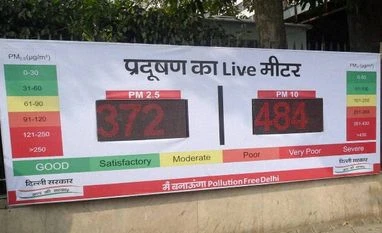Delhi's air quality remained 'very poor' due to the presence of substantial amount of particulate matter, largely due to atmospheric conditions, on a day the odd-even restriction came into force.
System of Air Quality and Weather Forecasting and Research (SAFAR) had yesterday said that air quality in Delhi was expected to deteriorate over the next few days with a possible rise in the level of particulate matter due to fall in minimum temperature and calm wind movement.
Officials said the air quality remained "very poor" today due to atmospheric conditions that did not allow pollutants to get dispersed.
SAFAR stations, located in various areas the city, displayed 'very poor' real-time Air Quality Index, which was in line with the forecast of the Union government body that was released yesterday.
In no marked change from yesterday, the average levels of PM 2.5 was around 180 microgrammes per cubic metre, three times above the safe limit of 60. The corresponding safe limit of PM 10 is 100.
Central Pollution Control Board's real time AQI for the Punjabi Bagh, R K Puram, NSIT Dwarka and Anand Vihar stations were 'severe' at 5 PM.
"The boundary layer, beyond which pollutants cannot escape, comes near the earth's surface during the early morning hours resulting in the accumulation of pollutants. So the spike that was observed around 5.30 AM and the subsequent fall is understandable," Project Director, SAFAR, Gufran Beig said.
Scientists also said that a straightforward comparison of today's pollution figures with last year's data would be "misleading" as weather was colder which had resulted in more pollution.
Tomorrow onwards, a sharp spike in the volume of PM 2.5 is expected due to possible fall in minimum temperature and calm wind movement, with it rising to 192 first and 201 by January 3. The corresponding figures for PM 10 are expected to be around 334 and 349.
Air quality is considered 'very poor' by Indian authorities when level of PM 2.5 ranges from 120 to 250 microgrammes per cubic metre.
System of Air Quality and Weather Forecasting and Research (SAFAR) had yesterday said that air quality in Delhi was expected to deteriorate over the next few days with a possible rise in the level of particulate matter due to fall in minimum temperature and calm wind movement.
Officials said the air quality remained "very poor" today due to atmospheric conditions that did not allow pollutants to get dispersed.
More From This Section
While a section of the ruling AAP attributed the sharp drop in PM 2.5 figures between early morning hours and afternoon to the car rationing experiment, scientists said pollutants usually touch their peak in the dawn and then gradually fall.
SAFAR stations, located in various areas the city, displayed 'very poor' real-time Air Quality Index, which was in line with the forecast of the Union government body that was released yesterday.
In no marked change from yesterday, the average levels of PM 2.5 was around 180 microgrammes per cubic metre, three times above the safe limit of 60. The corresponding safe limit of PM 10 is 100.
Central Pollution Control Board's real time AQI for the Punjabi Bagh, R K Puram, NSIT Dwarka and Anand Vihar stations were 'severe' at 5 PM.
"The boundary layer, beyond which pollutants cannot escape, comes near the earth's surface during the early morning hours resulting in the accumulation of pollutants. So the spike that was observed around 5.30 AM and the subsequent fall is understandable," Project Director, SAFAR, Gufran Beig said.
Scientists also said that a straightforward comparison of today's pollution figures with last year's data would be "misleading" as weather was colder which had resulted in more pollution.
Tomorrow onwards, a sharp spike in the volume of PM 2.5 is expected due to possible fall in minimum temperature and calm wind movement, with it rising to 192 first and 201 by January 3. The corresponding figures for PM 10 are expected to be around 334 and 349.
Air quality is considered 'very poor' by Indian authorities when level of PM 2.5 ranges from 120 to 250 microgrammes per cubic metre.
)